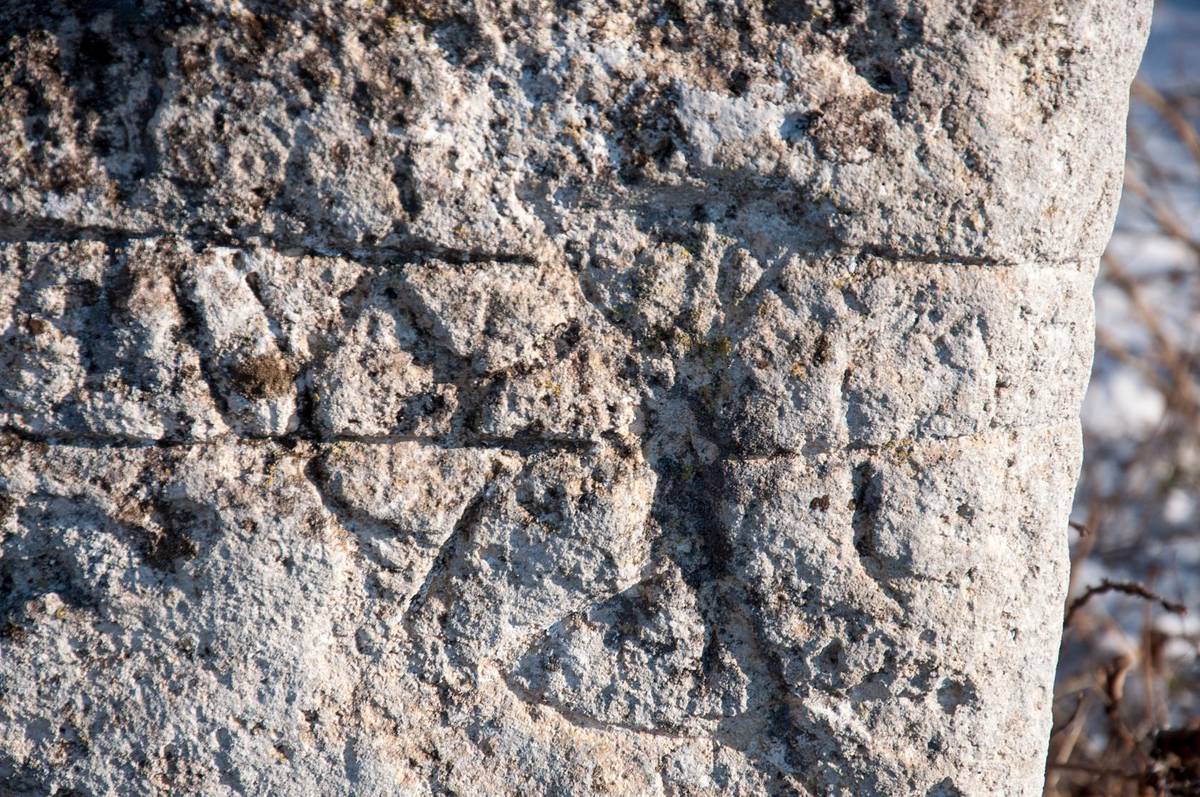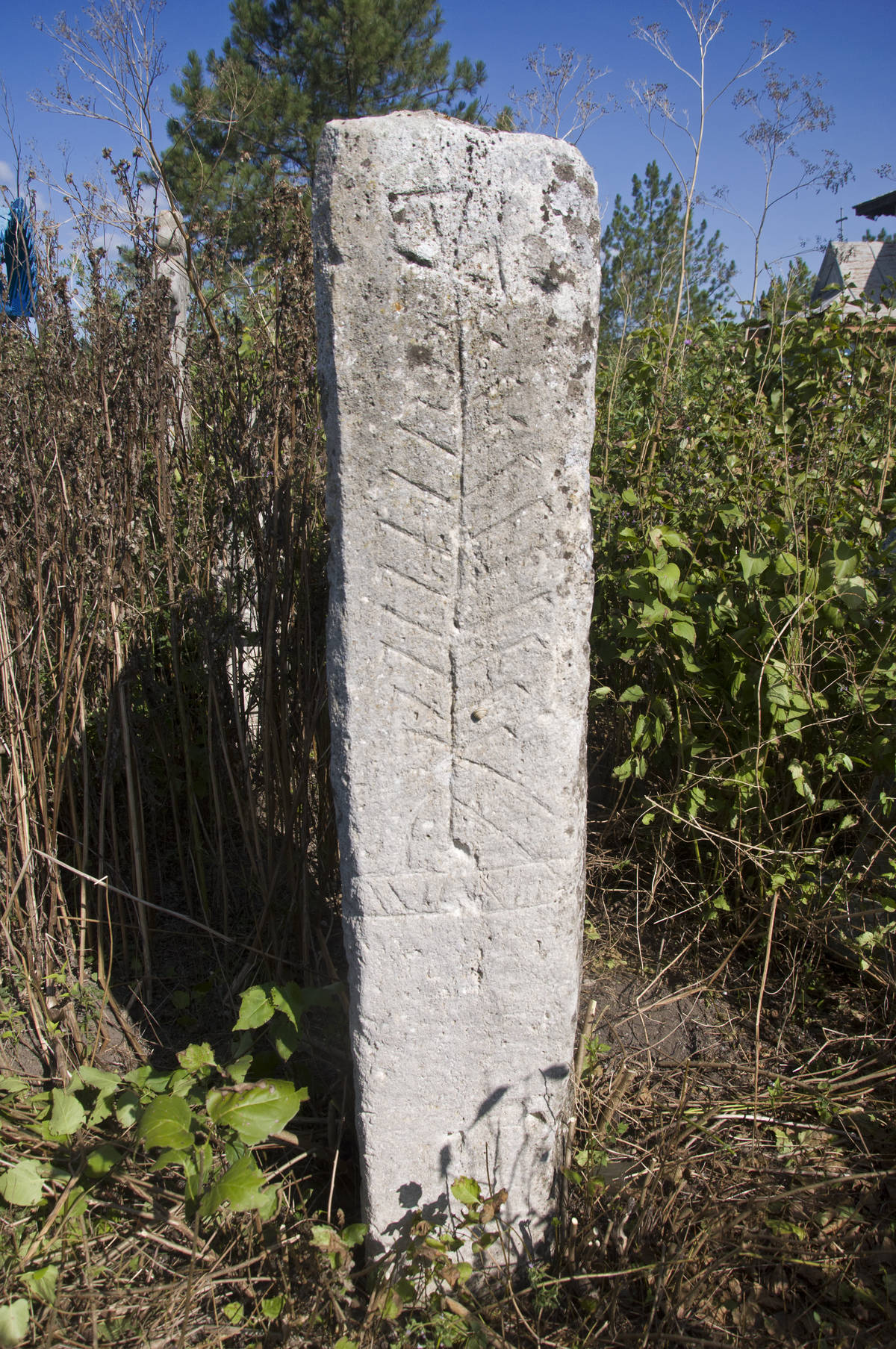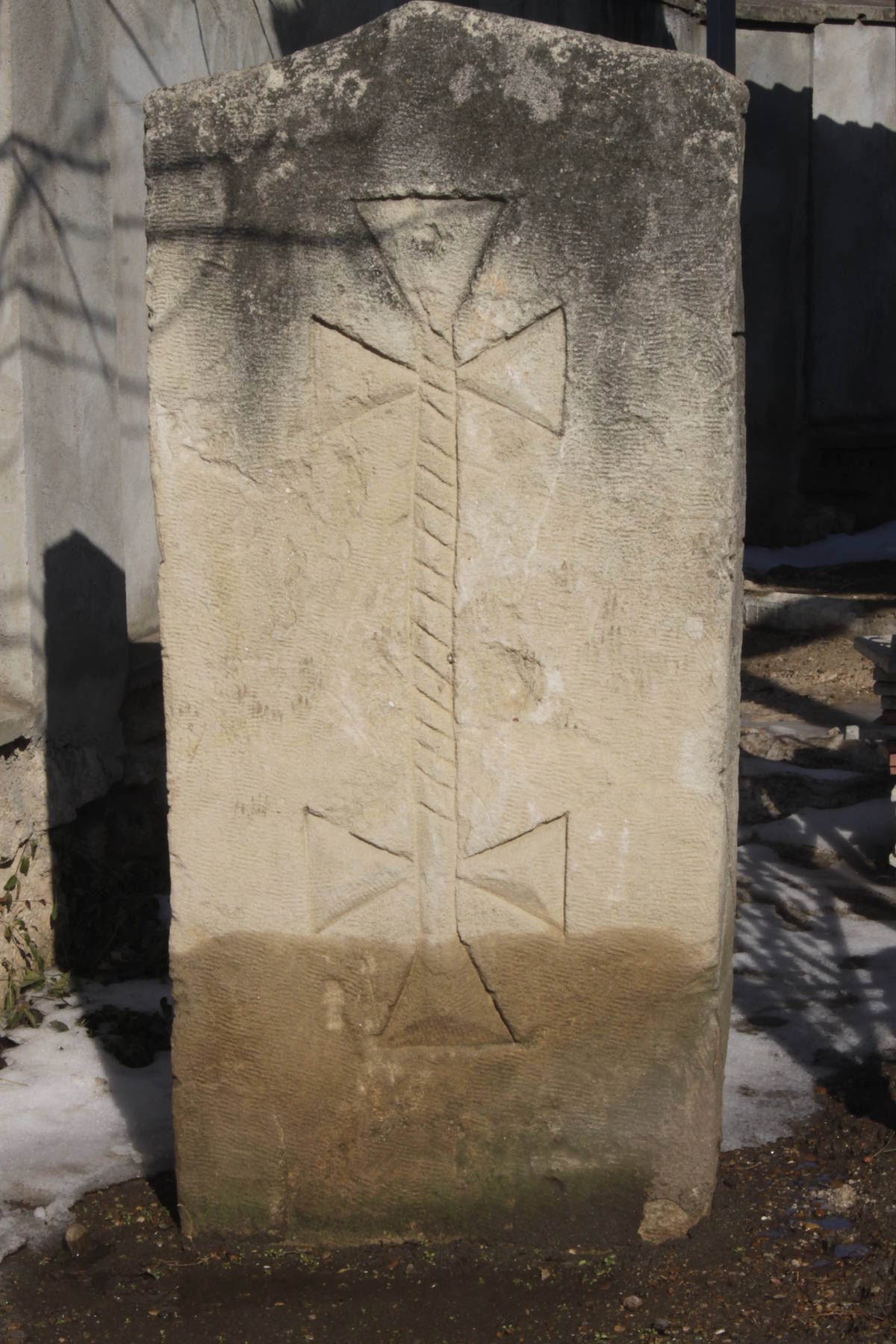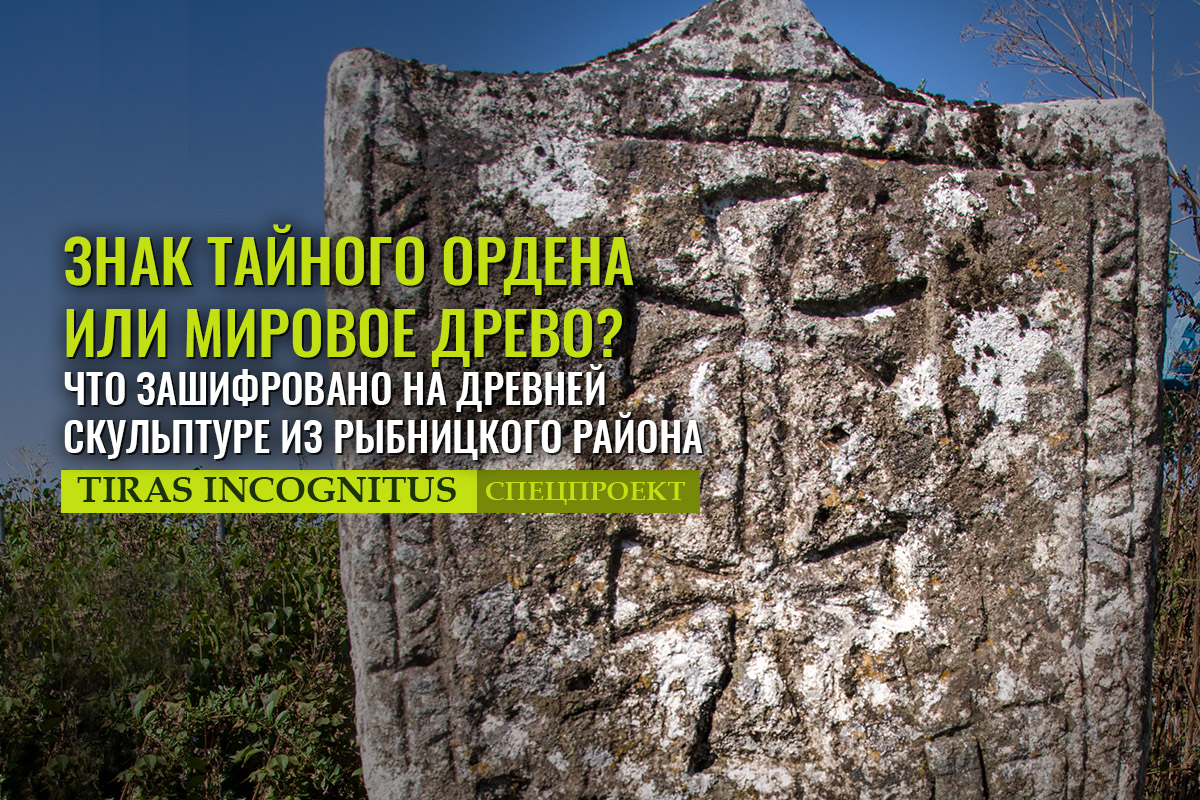In the village of Bolshoi Molokish, Rybnitsa district, there is an ancient stone stele, covered with mysterious symbols. Locals do not notice it. When asked what kind of unusual stone is located behind the cemetery fence and what the signs engraved on it indicate, the villagers answer, raising their eyebrows with surprise: do we have such in Molokish? Indeed, among the thickets and monuments of the rural necropolis, it is almost impossible to notice the old stone slab.
Particularly given that other objects attracts the attention of a curious guest. Without exaggeration, they can be called works of art: the magnificent marble tombstone with erased inscriptions and soaring stone crosses with octagonal rosettes are truly impressive with their delicate work. But the most amazing artifact is still a stele in the form of a human figure, which, according to experts, is about 5 thousand years old.

Side A. Photo by Alexander Palamar
The participants of the culture-based project Name on the Stone paid attention to this stone slab during expeditions to the Pridnestrovian regions. Researchers were attracted by its "ancient appearance" and numerous signs on both sides of the stele. The central image is a figure in the form of a double webbed cross in a frame of zigzag lines. It is present on opposite fronts, but the images are by no means identical: on the one side, the six-pointed figure looks symmetrical, on the other one, the lower triangles are noticeably smaller than the upper ones. In the latter case, the frame is not continuous, but made in the form of an elongated and U-shaped curved similar figure with two cross-shaped endings.

Side B. Photo by Grigory Bratus
The entire surface of the slab is dotted with miniature symbols of various shapes. As a rule, these are crosses with triangular limbs.
There are also lines with four streams, similar to the image of either a person or a tree.

There is also a figure in the form of two triangles connected by upper points.

Rectangles are also drawn on the stone, inside which there are intersecting lines drawn.

The floral ornament on the ribs of the stele is even more interesting. They are painted with numerous lines, in which the image of a tree is revealed. Its trunk, branches extended upwards and roots directed downwards are well visible. The top of the tree is crowned with the same cross on both sides of the slab.

According to the Candidate of Historical Sciences Sergey Razumov, this is not just a stone slab, but a sculpture from the distant Bronze Age. A staff member of the Archeology Research Laboratory of the Pridnestrovian State University examined the artifact and his conclusion is unequivocal: we have a stele with anthropomorphic features (that is, resembling a human being). In ancient such sculptures times stood on the mounds and hills, as if protecting the "sacred space". Their creators are considered to be representatives of ancient cultural and historical communities that lived in the Black Sea steppes more than 5 thousand years ago.
Today, such objects are very rare. Two such "magical stones" can be seen in Rybnitsa in the courtyard of the branch of the PSU named after T.G. Shevchenko. They were installed there as historical exhibits after archaeologists found them on a grape field near the village of Yantarnoye. These are the most ancient monumental sculptures in Pridnestrovie - they are more than 5 thousand years old. Actually, they were not able to avoid erosion.

A good idea of what ancient anthropomorphic steles looked like is provided by a Kernosovskiy idol from Ukraine.

Such stones are an excellent source for exploring ancient symbols. Scientists have been racking their brains over this vast topic for more than a decade, and although there is already a lot of data accumulated, no comprehensive interpretations had appeared.
It is believed that stone steles are associated with the cult of a sacred place, which, in the traditions of many nations of the world, has its spatial-relief features. One of them is natural or artificial heights, symbolizing the connection of two opposite worlds – the earth and the sky.
In the myths of different cultures, there is an image of the “axis of the world”, which is depicted as a pillar, hill, stairs, tree in iconography. In many traditions, one can find the idea of axial points as a gate to other worlds. Perhaps that is the reason why they served as a place where burials were committed, above which barrows were erected - sacred hills, topped with stone pillar-steles, as a symbolic designation of the axis.
The slab from the Bolshoi Molokish is also located on the dominant highlands. From here, a picturesque view is opened to the surroundings. Is it a coincidence that the Orthodox Church of the Dormition of the Mother of God was built on this very place? Here, in fact, at the ancient stele, a rural cemetery appeared. On the other hand, it is very strange that in the village there are not even legends about an ancient anthropomorphic stone, which, apparently, stood here long before the first rural house was built.
“Unfortunately, we did not find any information about the origin of the slab you are interested in,” the local museum responded to our request about a stone artifact.
Meanwhile, Sergey Razumov is sure that the symbols were engraved on the stele from Bolshoi Molokish already in another era, several millennia after the stone sculpture creation. They are far from the images characteristic of the cultures of the Bronze Age and the Age of Antiquity. Who and when drew them, and what they mean - these questions still remain unanswered.
But you can still find some clues. Similar symbols are carved on a limestone slab, which stands in the courtyard of the Orthodox Church of the Ascension in Grigoriopol.

Interestingly, this stele was found in the mud on the banks of the Dniester near the village of Teia in the Grigoriopol region ten years ago. But why was it transported over the fence of the temple of the district center? This story is also not entirely free of the air of mystery. Anyway, no one was able to tell us about it. It is possible that the drawing in the form of a double cross was taken for a Christian symbol (logically: the cross means Christianity, although the image of the cross was found long before the birth of Christ). Or perhabs the popular unconscious has worked: "Sacred stones must be in holy places."
In any case, this analogy alone cannot bring clarity to where the “double cross” came from and what it means. An attempt to understand this was undertaken by Nikolai Fech, a journalist from the Pridnestrovie newspaper, several years ago. His explorations, which look like adventure stories and, actually, are very easy to read, can be found here.
The author picked up the trail that brought him into the world of heraldry, secrets and assumptions. He found a visual correspondence of the mysterious signs with the emblem of the Lithuanian princely Jagiellonians dynasty, where a double cross is depicted on the rider's shield. But even there it appeared only at the end of the XIV century as a result of dynastic relations. Indeed, this symbol can be found on the emblems and coins of aristocratic families of Hungary, Great Moravia, and even the Slavic Branibor dukes (later renamed Brandenburg by the Germans).
Undoubtedly, it is possible to see a certain similarity between the presented heraldic symbols and signs of stone slabs. But it is not clear whether there is a connection between them. What if they are not crosses, but a stylized image of a tree? Especially given that we see a floral ornament on the edge of the stele from Bolshoi Molokish.
It is possible that we see the Worlds Tree, or the Tree of Life - a symbol encountered in the heritage of many ancient cultures. The symbolism of this image is quite extensive - from the life cycle to the cosmogonic structure of the Universe, where the roots are the lower spheres, the branches are the middle worlds, the crown is the higher spaces, and the trunk is the tunnel between them. It is believed that the image of the Tree is associated with the symbol of transition and transformation. Maybe it is not by chance that it is present on an ancient anthropomorphic stele, which, as we noted above, refers to the cult of a sacred place - the intersection point of the worlds. In addition, the image of the tree is closely intertwined with the ancient concepts of the Universe. Such an assumption could well have been made by specialists in comparative religious studies.
Actually, the "double crosses" of the mysterious slabs lead to various associations. A fancy writer might as well have connected those signs, for example, with a long-vanished knightly order, whose brothers, by the will of fate, ended up in those lands, where, as historians say, there was a deserted Tartary. He would say in response to the skeptical smiles of his interlocutors that no one knows what happened to the Templars after their defeat by the French royal house of Valois.
But these are only images coming out of rich imagination, without which, however, scientific and creative progress would be impossible. You can only get to the bottom of the mystery by painstakingly collecting data, fragments of which, sooner or later, will allow you to create a full picture and come to logical conclusions. We will present some of such “double cross” puzzles in our next material.
Аlexander Koretsky








